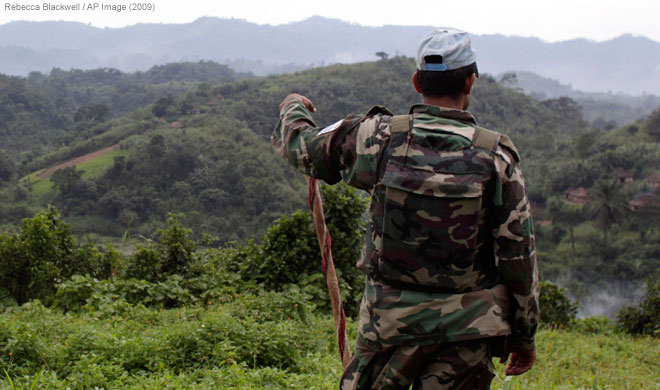
Editor's Note: Enough Project intern Jasper Kubasek contribited to this post.
In a new report, “How to Dismantle a Deadly Militia” the Enough Project sets out seven key non-military approaches to help end the FDLR’s ability to continue to threaten peace and security in eastern Democratic Republic of Congo and the region.
Following six months of research and interviews with armed commanders, civil society leaders, diplomats, ex-combatants, refugees, and military experts in eastern Congo on the topic of how to help end the deadly FDLR armed group, Enough released this report, offering seven policy proposals for diplomats such as U.S. Special Envoy Russ Feingold, U.N. Special Envoy Said Djinnit, and others to take action.
The research found that the armed group in Congo known as the FDLR is currently regrouping, mobilizing political support, and continuing to pose a threat to regional security. The FDLR (a French acronym for “Forces démocratiques de libération du Rwanda”) is one of the most prominent and abusive armed groups in Congo and Rwanda, formerly known as the Interahamwe/ex-FAR and ALiR. Several of its leaders were involved in helping perpetrate the Rwandan genocide, and it has committed repeated massacres against civilians in eastern Congo. Several currently active armed groups in Congo state that combatting the FDLR is the reason they themselves remain active.
The UN Security Council and regional African governments have set a deadline for the FDLR to fully disarm by January 2, 2015 or face military action. While it is unclear who exactly will undertake this military action, as Congo and the troop-contributing countries of the UN Intervention Brigade (mainly South Africa and Tanzania) have hesitated to use force against this stated enemy of Rwanda, international diplomats and regional governments, including Congo, can take action on several non-military fronts.
Taking a military approach to ending the FDLR presents a significant set of issues, most notably the fact that the FDLR embeds itself in local communities and refugee populations, creating a legitimate risk that counter-FDLR operations will cause civilian casualties. This risk can be mitigated if operations using special forces target the FDLR leadership and also incorporate strong civilian protection measures. Since the defeat of the M23 rebel group in November 2013, the FDLR has received significant attention in both the region and the broader international community as the next main armed group to address. This attention, however, has translated into little policy action.
Although the FDLR claims that its fighters are in the process of disarming, the group has failed to meet several deadlines set by the UN Security Council and regional African governments. Evidence from UN experts and findings from Enough Project field research in Congo suggest that the FDLR’s current strategy is focused on reorganizing itself in three main areas:
- generating more income to trade for ammunition and weapons, particularly through trading gold through Uganda and charcoal from Virunga National Park to Goma
- mobilizing political support in an attempt to gain greater legitimacy
- preparing to avoid military defeat through alliance-building and recruitment
Defeating the FDLR will require a comprehensive strategy that incorporates both targeted military approaches and diplomatic action on non-military areas. In particular, the FDLR’s collaboration with the Congolese army and its economic lifelines must be cut off.
How to Dismantle a Deadly Militia makes 7 key recommendations:
- Regional diplomacy. U.N. Special Envoy Said Djinnit should continue to proactively repair relations between Rwanda and South Africa as well as relations between Rwanda and Tanzania. The aim should be to forge regional consensus for both targeted military operations and urgently-needed non-military measures to neutralize the FDLR.
- Cutting off the FDLR’s economic lifelines, including charcoal. U.S. and UN representatives should bolster the Virunga National Park rangers’ (also known as The Congolese Institute for Nature Conservation, or ICCN) plans to to halt the FDLR’s charcoal supply routes from Virunga National Park to Goma.
- Accountability for Congolese army officers. U.N. and U.S. diplomats should escalate pressure on the Congolese government to investigate, suspend, and indict Congolese military officers who are suspected of collaborating with the FDLR. The issue should be placed on the agendas of the ICGLR high-level talks and the U.N. Security Council. Such collaboration is a major issue, because it enables the rebels to avoid attacks and resupply.
- Work to apprehend FDLR leader Sylvestre Mudacumura and encourage public indictments. UN Special Envoy Said Djinnit, U.S. Special Envoy Russ Feingold, and Angolan President José dos Santos should urge MONUSCO and the Congolese government to cooperate with the International Criminal Court, apprehend Mudacumura, and strengthen the case against him.
- Third-country resettlement. Concrete regional resettlement options should be developed for FDLR combatants who are not indicted for atrocity crimes and who have a fear of return to Rwanda. Such offers should include the protective measures necessary to encourage increased defection.
- Refugees. Djinnit, Feingold, and Kobler should work with the U.N. High Commissioner for Refugees (UNHCR) to set up protected camps for refugees in eastern Congo. The envoys should also ensure that MONUSCO provides security for the camps.
- Security guarantees. Djinnit, Feingold, and dos Santos should work with Rwanda to provide an improved security plan that is co-signed by international actors and to issue a new statement that would outline more concrete plans for security and non-prosecution guarantees for FDLR combatants not indicted for grave crimes.
Editor's note: Enough Project intern Jasper Kubasek contributed to this post.
Photo credit: Rebecca Blackwell/AP (2009)

